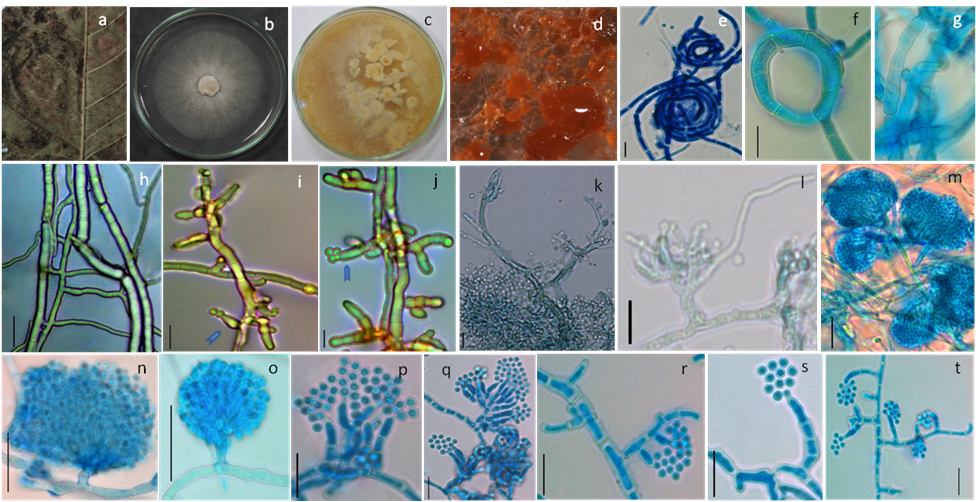Lambertella dipterocarpacearum
MycoBank number: MB 842519; Index Fungorum number: IF 842519; Facesoffungi number: FoF 0773601;
Synonyms: No synonyms
Description
On leaf of Shorea robusta in terrestrial habitats. Asexual morph vegetative hyphae smooth walled, branched, septate, anastomoses, sometimes coiled subhyaline to light olivaceous up to 10.15 µm wide. Stroma none. Chlamydospores absent. Stroma none. Chlamydospores absent. Setae and hyphopodia absent. Conidiophores macronematous, mononematous, unbranched to dichotomously densely branched, straight, short, septate, smooth walled, subhyaline to light olivaceous, 4.5–138.90 x 4–6.35μm, sometimes reduced into conidiogenous cells. Conidiogenous cells holoblastic, terminal to lateral, determinate, polyblastic, ampulliform, persistent, aseptate, hyaline, 2.88–12.75 x 1.61–7.20μm ( = 6.30. x 2.70μm, n = 30). Phialides solitary or aggregated, densely produced, ampulliform to lageniform, smooth walled, hyaline, 2.59–22.92 x 1.67–4μm ( = 6.31. x 2.73μm, n = 30). Conidia mostly aggregated in slimy mass heads at the apex of phialides, sometimes produced in chains, globose to sub-globose, smooth walled, sub-hyaline to light olivaceous, 1.84–4.22 x 1.81–2.80 μm ( = 2.38. x 2μm, n = 30). Sexual morph Undetermined.
Culture characteristics: on semi-synthetic agar medium PDA (Potato Dextrose Agar) white (1A-1), reaching 6.5 cm diam. in 5 days at 25°C, with irregular margin, surface filamentous, reverse light yellow (4A-4). Hyphae septate, unbranched to branched, sometimes constricted near septa, smooth and thin walled, subhyaline to light olivaceous, 2–10.15 μm wide.
Materials examined: INDIA, Uttar Pradesh, Gorakhpur District, on Shorea robusta (leaf infested with black mold), 5th May 2016, P.N. Singh, (AMH10226 holotype); ex type living culture, NFCCI 4826 (National Fungal Culture Collection of India- WDCM 932).
Distribution: India (in this paper).
Sequence data: ITS: MT227126; LSU: MT227018
Notes: Lambertella dipterocarpacearum will be a new species (Singh, Singh and Lagashetti 2022) in this isolate the sexual stage was not found from the substrate as well as in vitro culture on the holotype.
Importance and role: To our knowledge for the first time, this fungus was isolated from leaf of Shorea robusta (Dipterocarpaceae) collected from Kusumi Forest, District Gorakhpur, Uttar Pradesh, India. Moreover, this genus is being reported for the first time from India. Because this fungus was isolated from mold association fungus, it may be growing mutually/coexist and it can play role as either mutuaulistic behavior or hyper-parasitic with the mold fungal genera like Saksenamyces and Spiropes.
Importance of genus to humans or ecosystem: Not studied
Industrial relevance and applications: Not studied
Quarantine significance: Lambertella dipterocarpacearum was isolated from Shorea robusta (Roth) leaf and the leaf was found associated Cercosporoid genus Saksenamyces and a black mold genus Spiropes, in such condition it may not disassociate from leaf and thus it may not provide a pathway for this fungus. Therefore, quarantine assessment is probably not required unless it proves to be pathogenic to crop and livestock (Quarantine significance).
Biochemical importance of the species: not studied.
Chemical diversity or applications: not studied

Fig. 1 Lambertella dipterocarpacearum (AMH10226, holotype). a Substratum (leaf of Shorea). b Colony morphology on PDA (front view on 5th days). c Colony morphology on PDA (front view on 15th days). d Stereomicroscopic surface view of colony showing dark orange shiny gleosporic mass of conidial heads. e–h Coiled anastomosed hyphae. i–j developing phialides bearing conidia from hyphae (showing arrow). k–l Branched conidiophores (arrow showing sterile arm. m–o Conidiophores with conidial heads. p –t Different types of patterns of conidiophores and arrangement of conidia on phialides. Scale bars e – g = 10 μm, h=20 μm, i = 10 μm, j= 5 μm, k–l= 10 μm, m–o= 20 μm, p-t= 10 μm.
